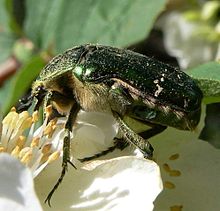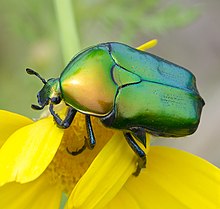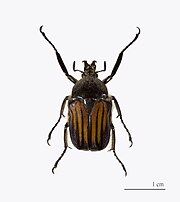| Flower chafer | |
|---|---|

| |
| Cetonia aurata, the green rose chafer | |
| Scientific classification | |
| Domain: | Eukaryota |
| Kingdom: | Animalia |
| Phylum: | Arthropoda |
| Class: | Insecta |
| Order: | Coleoptera |
| Suborder: | Polyphaga |
| Infraorder: | Scarabaeiformia |
| Family: | Scarabaeidae |
| Subfamily: | Cetoniinae Leach, 1815 |
Flower chafers are a group of scarab beetles comprising the subfamily Cetoniinae. Many species are diurnal and visit flowers for pollen and nectar, or to browse on the petals. Some species also feed on fruit. The group is also called fruit and flower chafers, flower beetles and flower scarabs. There are around 4,000 species, many of them still undescribed.
Ten tribes are presently recognized: Cetoniini, Cremastocheilini, Diplognathini, Goliathini, Gymnetini, Phaedimini, Schizorhinini, Stenotarsiini, Taenioderini, and Xiphoscelidini. The former tribes Trichiini and Valgini were elevated in rank to subfamily. The tribe Gymnetini is the biggest of the American tribes, and Goliathini contains the largest species, and is mainly found in the rainforest regions of Africa.
Description
Adult flower chafers are usually brightly coloured beetles, often metallic, and somewhat flattened in shape. The insertions of the antennae are visible from above, while the mandibles and labrum are hidden by the clypeus. The elytra lack a narrow membranous margin and are truncate to expose the pygidium. The abdominal spiracles are diverging so that several lie on the abdominal sternites with at least one exposed. The fore coxae are conical and produced ventrally, while the mid coxae are transverse or only slightly oblique. The mesothoracic epimera is visible from above. The tarsi are each equipped with a pair of simple (not forked) tarsal claws of subequal size.
A feature possessed by adults of many flower chafers, especially Cetoniini, is lateral emargination of the elytra.
Larvae are stout-bodied and very hairy with short legs. The head is partly covered by the prothorax. Each antenna has the apical segment as wide as the penultimate segment. The galea and lacinia are used to form a mala. The anal cleft is transverse. The mandible has a ventral stridulating area. The labrum is symmetrical with a deeply pigmented notch on each side of the midline.
Biology
Adult cetoniines are herbivorous, being found on flowers (from which they consume nectar and pollen), tree sap and rotting fruit. Larvae generally live and feed in decaying plant matter (including decaying wood) or soil. In captivity, cetoniine larvae will feed on soft fruit.
Many species in the tribe Cremastocheilini are known to be predaceous, feeding on hymenopteran larvae or soft-bodied nymphs of Auchenorrhyncha. Spilophorus spp. have been noted feeding on the nesting material and excrement of South African passerine birds, while Spilophorus maculatus has been recorded feeding on Oxyrhachis sp. nymphs and Hoplostomus fuligineus is known to feed on the brood of honey bees in South Africa and the pupae of the wasp Belonogaster petiolata. Campsiura javanica feeds on the larvae of Ropalidia montana in southern India. Cremastocheilus stathamae feeds on ants of the genus Myrmecocystus.
In terms of movement, adults are considered some of the best flyers among beetles. They can hover above and land on flowers or fruit. When threatened by predators, they escape by either performing a rush take off or by falling toward the ground and then flying before impact. Many cetoniines fly with their elytra closed, as their hindwings can unfold and slide out under the elytra during flight (thanks to the emargination of the elytra).
Larvae of some taxa can crawl on their backs using their tergal folds, which are covered in strong bristles. Others crawl on their legs.
Systematics and taxonomy




The following list contains the genera and subtribes in ten tribes of subfamily Cetoniinae, according to Catalogue of Life and Scarabaeidae of the World (2023).
Cetoniini
Authority: Leach, 1815
- Subtribe Cetoniina Leach, 1815
- Aethiessa Burmeister, 1842
- Anatona Burmeister, 1842
- Anelaphinis Kolbe, 1892
- Aphelinis Antoine, 1987
- Atrichelaphinis Kraatz, 1898
- Atrichiana Distant, 1911
- Badizoblax Thomson, 1877
- Centrantyx Fairmaire, 1884
- Cetonia Fabricius, 1775
- Chewia Legrand, 2004
- Chiloloba Burmeister, 1842
- Cosmesthes Kraatz, 1880
- Cosmiophaena Kraatz, 1898
- Dischista Burmeister, 1842
- Dolichostethus Kolbe, 1892
- Elaphinis Burmeister, 1842
- Enoplotarsus Lucas, 1859
- Erlangeria Preiss, 1902
- Gametis Burmeister, 1842
- Gametoides Antoine, 2005
- Glycosia Schoch, 1896
- Glycyphana Burmeister, 1842
- Gymnophana Arrow, 1910
- Hemiprotaetia Mikšić, 1963
- Heterocnemis Albers, 1852
- Heterotephraea Antoine, 2002
- Lorkovitschia Mikšić, 1968
- Marmylida Thomson, 1880
- Mireia Ruter, 1953
- Niphobleta Kraatz, 1880
- Pachnoda Burmeister, 1842
- Pachnodoides Alexis & Delpont, 2002
- Pachytephraea De Palma & Malec, 2020
- Paleopragma Thomson, 1880
- Paranelaphinis Antoine, 1988
- Paraprotaetia Moser, 1907
- Pararhabdotis Kraatz, 1899
- Parastraella Antoine, 2005
- Paraxeloma Holm, 1988
- Parelaphinis Marais & Holm, 1989
- Phaneresthes Kraatz, 1894
- Phonotaenia Kraatz, 1880
- Phoxomeloides Schoch, 1898
- Podopholis Moser, 1915
- Podopogonus Moser, 1917
- Pogonopus Arrow, 1910
- Polystalactica Kraatz, 1882
- Protaetia Burmeister, 1842
- Protaetiomorpha Mikšić, 1968
- Pseudotephraea Kraatz, 1882
- Reineria Mikšić, 1968
- Rhabdotis Burmeister, 1842
- Rhabdotops Krikken, 1981
- Rhyxiphloea Burmeister, 1842
- Ruteraetia Krikken, 1980
- Simorrhina Kraatz, 1886
- Somalibia Lansberge, 1882
- Stalagmosoma Burmeister, 1842
- Systellorrhina Kraatz, 1895
- Tephraea Burmeister, 1842
- Thyreogonia Reitter, 1898
- Trichocephala Moser, 1916
- Tropinota Mulsant, 1842
- Walsternoplus Allsopp, Jákl & Rey, 2023
- Xeloma Kraatz, 1881
- Subtribe Euphoriina Horn, 1880
- Chlorixanthe Bates, 1889
- Euphoria Burmeister, 1842
- Subtribe Leucocelina Kraatz, 1882
- Acrothyrea Kraatz, 1882
- Alleucosma Schenkling, 1921
- Amaurina Kolbe, 1895
- Analleucosma Antoine, 1989
- Cyrtothyrea Kolbe, 1895
- Discopeltis Burmeister, 1842
- Grammopyga Kolbe, 1895
- Heteralleucosma Antoine, 1989
- Homothyrea Kolbe, 1895
- Leucocelis Burmeister, 1842
- Lonchothyrea Kolbe, 1895
- Mausoleopsis Lansberge, 1882
- Mecaspidiellus Antoine, 1997
- Molynoptera Kraatz, 1897
- Molynopteroides Antoine, 1989
- Oxythyrea Mulsant, 1842
- Paleira Reiche, 1871
- Paralleucosma Antoine, 1989
- Phoxomela Schaum, 1844
- Pseudalleucosma Antoine, 1989
- Pseudooxythyrea Baraud, 1985
Cremastocheilini
Authority: Burmeister & Schaum, 1841
- Subtribe Aspilina Krikken, 1984
- Aspilochilus Rojkoff, 2013
- Aspilus Westwood, 1874
- Protochilus Krikken, 1976
- Subtribe Coenochilina Burmeister, 1842
- Arielina Rossi, 1958
- Astoxenus Péringuey, 1907
- Basilewskynia Schein, 1957
- Coenochilus Schaum, 1841
- Subtribe Cremastocheilina Burmeister & Schaum, 1841
- Centrochilus Krikken, 1976
- Clinterocera Motschulsky, 1857
- Cremastocheilus Knoch, 1801
- Cyclidiellus Krikken, 1976
- Cyclidinus Westwood, 1874
- Cyclidius MacLeay, 1838
- Genuchinus Westwood, 1874
- Lissomelas Bates, 1889
- Paracyclidius Howden, 1971
- Platysodes Westwood, 1874
- Psilocnemis Burmeister, 1842
- Subtribe Cymophorina Krikken, 1984
- Cymophorus Kirby, 1827
- Myrmecochilus Wasmann, 1900
- Rhagopteryx Burmeister, 1842
- Subtribe Genuchina Krikken, 1984
- Genuchus Kirby, 1825
- Meurguesia Ruter, 1969
- Problerhinus Deyrolle, 1864
- Subtribe Goliathopsidina Krikken, 1984
- Goliathopsis Janson, 1881
- Subtribe Heterogeniina Krikken, 1984
- Heterogenius Moser, 1911
- Pseudastoxenus Bourgoin, 1921
- Subtribe Lissogeniina Krikken, 1984
- Chthonobius Burmeister, 1847
- Lissogenius Schaum, 1844
- Subtribe Macromina Burmeister & Schaum, 1842
- Brachymacroma Kraatz, 1896
- Campsiura Hope, 1831
- Macromina Westwood, 1874
- Pseudopilinurgus Moser, 1918
- Subtribe Nyassinina Krikken, 1984
- Nyassinus Westwood, 1879
- Subtribe Oplostomina Krikken, 1984
- Anatonochilus Péringuey, 1907
- Oplostomus MacLeay, 1838
- Placodidus Péringuey, 1900
- Scaptobius Schaum, 1841
- Subtribe Pilinurgina Krikken, 1984
- Callynomes Mohnike, 1873
- Centrognathus Guérin-Méneville, 1840
- Parapilinurgus Arrow, 1910
- Periphanesthes Kraatz, 1880
- Pilinurgus Burmeister, 1842
- Priska Jákl, 2018
- Subtribe Spilophorina Krikken, 1984
- Spilophorus Westwood, 1848
- Subtribe Telochilina Krikken, 1984
- Telochilus Krikken, 1975
- Subtribe Trichoplina Krikken, 1984
- Lecanoderus Kolbe, 1907
- Trichoplus Burmeister, 1842
- Subtribe Trogodina Krikken, 1984
- Pseudoscaptobius Krikken, 1976
- Trogodes Boheman, 1857
Diplognathini
Authority: Burmeister, 1842
- Anoplocheilus MacLeay, 1838
- Anthracophora Burmeister, 1842
- Anthracophorides Moser, 1918
- Apocnosoides Antoine, 2001
- Charadronota Burmeister, 1842
- Conradtia Kolbe, 1892
- Diphrontis Gerstaecker, 1882
- Diplognatha Gory & Percheron, 1833
- Eriulis Burmeister, 1842
- Hadrodiplognatha Kraatz, 1898
- Heteropseudinca Valck Lucassen, 1933
- Lamellothyrea Krikken, 1980
- Metallopseudinca Valck Lucassen, 1933
- Niphetophora Kraatz, 1883
- Nselenius (Holm & Perissinotto, 2004)
- Odontorrhina Burmeister, 1842
- Parapoecilophila Hauser, 1904
- Phonopleurus Moser, 1919
- Pilinopyga Kraatz, 1888
- Porphyronota Burmeister, 1842
- Pseudinca Kraatz, 1880
- Stethopseudinca Valck Lucassen, 1933
- Tetragonorrhina Kraatz, 1896
- Trichostetha Burmeister, 1842
- Triplognatha Krikken, 1987
- Trymodera Gerstaecker, 1867
- Uloptera Burmeister, 1842
Goliathini
Authority: Latreille, 1829
- Subtribe Dicronocephalina Krikken, 1984
- Dicronocephalus Hope, 1831
- Platynocephalus Westwood, 1854
- Subtribe Goliathina Latreille, 1829
- Fornasinius Bertoloni, 1852
- Goliathus Lamarck, 1801
- Hegemus Thomson, 1881
- Hypselogenia Burmeister, 1840
- Subtribe Ichnestomina Burmeister, 1842
- Gariep Péringuey, 1907
- Ichnestoma Gory & Percheron, 1833
- Karooida Perissinotto, 2020
- Mzansica Perissinotto, 2020
- Subtribe Rhomborhinina Westwood, 1842
- Anagnathocera Arrow, 1922
- Anisorrhina Westwood, 1842
- Asthenorhella Westwood, 1874
- Asthenorhina Westwood, 1843
- Bietia Fairmaire, 1898
- Caelorrhina Hope, 1841
- Cheirolasia Westwood, 1842
- Chloresthia Fairmaire, 1905
- Chlorocala Kirby, 1828
- Chondrorrhina Kraatz, 1880
- Compsocephalus White, 1845
- Cosmiomorpha Saunders, 1852
- Cyphonocephalus Westwood, 1842
- Desfontainesia Alexis & Delpont, 1999
- Dicellachilus Waterhouse, 1905
- Dicheros Gory & Percheron, 1833
- Dicronorhina Hope, 1837
- Diphyllomorpha Hope, 1843
- Dymusia Burmeister, 1842
- Euchloropus Arrow, 1907
- Eudicella White, 1839
- Eutelesmus Waterhouse, 1880
- Gnathocera Kirby, 1825
- Gnorimimelus Kraatz, 1880
- Hemiheterorrhina Mikšić, 1974
- Herculaisia Seilliere, 1910
- Heterorhina Westwood, 1842
- Ingrisma Fairmaire, 1893
- Ischnoscelis Burmeister, 1842
- Jumnos Saunders, 1839
- Lansbergia Ritsema, 1888
- Lophorrhina Westwood, 1842
- Lophorrhinides Perissinotto, Clennell & Beinhundner, 2019
- Mawenzhena Alexis & Delpont, 2001
- Mecynorhina Hope, 1837
- Moseriana Ruter, 1965
- Mystroceros Burmeister, 1842
- Narycius Dupont, 1835
- Neomystroceros Alexis & Delpont, 1998
- Neophaedimus Lucas, 1870
- Neoscelis Schoch, 1897
- Pedinorrhina Kraatz, 1880
- Plaesiorrhina Westwood, 1842
- Petrovitzia Mikšić, 1965
- Priscorrhina Krikken, 1984
- Pseudodiceros Mikšić, 1974
- Pseudotorynorrhina Mikšić, 1967
- Ptychodesthes Kraatz, 1883
- Raceloma Thomson, 1877
- Rhamphorrhina Klug, 1855
- Rhinarion Ruter, 1965
- Rhomborhina Hope, 1837
- Scythropesthes Kraatz, 1880
- Smicorhina Westwood, 1847
- Spelaiorrhina Lansberge, 1886
- Stephanorrhina Burmeister, 1842
- Taurhina Burmeister, 1842
- Tmesorrhina Westwood, 1841
- Torynorrhina Arrow, 1907
- Trichoneptunides Legrand, 2001
- Trigonophorinus Pouillaude, 1913
- Trigonophorus Hope, 1831
Gymnetini
Authority: Kirby, 1827
- Subtribe Blaesiina Schoch, 1895
- Blaesia Burmeister, 1842
- Halffterinetis Morón & Nogueira, 2007
- Subtribe Gymnetina Kirby, 1827
- Allorrhina Burmeister, 1842
- Amazula Kraatz, 1882
- Amithao Thomson, 1878
- Argyripa Thomson, 1878
- Astroscara Schürhoff, 1937
- Badelina Thomson, 1880
- Balsameda Thomson, 1880
- Chiriquibia Bates, 1889
- Clinteria Burmeister, 1842
- Clinteroides Schoch, 1898
- Cotinis Burmeister, 1842 - (Green June Beetles)
- Desicasta Thomson, 1878
- Guatemalica Neervoort Van De Poll, 1886
- Gymnephoria Ratcliffe, 2019
- Gymnetina Casey, 1915
- Gymnetis MacLeay, 1819
- Hadrosticta Kraatz, 1892
- Heterocotinis Martinez, 1948
- Hologymnetis Martinez, 1949
- Hoplopyga Thomson, 1880
- Hoplopygothrix Schürhoff, 1933
- Howdenypa Arnaud, 1993
- Jansonia Schürhoff, 1937
- Macrocranius Schürhoff, 1935
- Madiana Ratcliffe & Romé, 2019
- Marmarina Kirby, 1827
- Neocorvicoana Ratcliffe & Mico, 2001
- Pseudoclinteria Kraatz, 1882
- Stethodesma Bainbridge, 1840
- Tiarocera Burmeister, 1842
Phaedimini
Authority: Schoch, 1894
- Hemiphaedimus Mikšić, 1972
- Phaedimus Waterhouse, 1841
- Philistina MacLeay, 1838
- Theodosia Thomson, 1880
Schizorhinini
Authority: Burmeister, 1842
- Subtribe Lomapterina Burmeister, 1842
- Agestrata Eschscholtz, 1829
- Ischiopsopha Gestro, 1874
- Lomaptera Gory & Percheron, 1833
- Macronota Hoffmannsegg, 1817
- Megaphonia Schürhoff, 1933
- Morokia Janson, 1905
- Mycterophallus Neervoort Van De Poll, 1886
- Thaumastopeus Kraatz, 1885
- Subtribe Schizorhinina Burmeister, 1842
- Anacamptorrhina Blanchard, 1842
- Aphanesthes Kraatz, 1880
- Aurum Hutchinson & Moeseneder, 2019
- Axillonia Krikken, 2018
- Bisallardiana Antoine, 2003
- Chalcopharis Heller, 1902
- Chlorobapta Kraatz, 1880
- Chondropyga Kraatz, 1880
- Clithria Burmeister, 1842
- Diaphonia Newman, 1840
- Dichrosoma Kraatz, 1885
- Digenethle Thomson, 1877
- Dilochrosis Thomson, 1878
- Eupoecila Burmeister, 1842
- Grandaustralis Hutchinson & Moeseneder, 2013
- Hemichnoodes Kraatz, 1880
- Hemipharis Burmeister, 1842
- Kerowagia Delpont, 1996
- Lenosoma MacLeay, 1863
- Lyraphora Kraatz, 1880
- Macrotina Strand, 1934
- Metallesthes Kraatz, 1880
- Microdilochrosis Jákl, 2009
- Microlomaptera Kraatz, 1885
- Micropoecila Kraatz, 1880
- Navigator Moeseneder & Hutchinson, 2016
- Neoclithria Neervoort Van De Poll, 1886
- Neorrhina Thomson, 1878
- Octocollis Moeseneder & Hutchinson, 2012
- Panglaphyra Kraatz, 1880
- Peotoxus Krikken, 1983
- Poecilopharis Kraatz, 1880
- Pseudoclithria Neervoort Van De Poll, 1886
- Rigoutorum Hutchinson & Moeseneder, 2022
- Schizorhina Kirby, 1825
- Schochidia Berg, 1898
- Stenopisthes Moser, 1913
- Storeyus Hasenpusch & Moeseneder, 2010
- Tafaia Valck Lucassens, 1939
- Tapinoschema Thomson, 1880
- Territonia Krikken, 2018
- Trichaulax Kraatz, 1880
Stenotarsiini
Authority: Kraatz, 1880
- Subtribe Anochiliina Krikken, 1984
- Anochilia Burmeister, 1842
- Epistalagma Fairmaire, 1880
- Subtribe Chromoptiliina Krikken, 1984
- Chromoptilia Westwood, 1842
- Descarpentriesia Ruter, 1964
- Subtribe Coptomiina Schenkling, 1921
- Bricoptis Burmeister, 1842
- Coptomia Burmeister, 1842
- Coptomiopsis Pouillaude, 1919
- Eccoptomia Kraatz, 1880
- Euchilia Burmeister, 1842
- Euryomia Burmeister, 1842
- Heterocranus Bourgoin, 1919
- Hiberasta Fairmaire, 1901
- Hyphelithia Kraatz, 1880
- Liostraca Burmeister, 1842
- Micreuchilia Pouillaude, 1917
- Micropeltus Blanchard, 1842
- Pareuchilia Kraatz, 1880
- Pygora Burmeister, 1842
- Pyrrhopoda Kraatz, 1880
- Vieuella Ruter, 1964
- Subtribe Doryscelina Schenkling, 1921
- Doryscelis Burmeister, 1842
- Epixanthis Burmeister, 1842
- Hemiaspidius Krikken, 1982
- Pararhynchocephala Paulian, 1991
- Parepixanthis Kraatz, 1893
- Pseudepixanthis Kraatz, 1880
- Rhynchocephala Fairmaire, 1883
- Subtribe Euchroeina Paulian & Descarpentries, 1982
- Euchroea Burmeister, 1842
- Subtribe Heterophanina Schoch, 1894
- Heterophana Burmeister, 1842
- Oxypelta Pouillaude, 1920
- Pogoniotarsus Kraatz, 1880
- Pogonotarsus Burmeister, 1842
- Zebinus Fairmaire, 1894
- Subtribe Heterosomatina Krikken, 1984
- Heterosoma Schaum, 1844
- Plochilia Fairmaire, 1896
- Subtribe Pantoliina Krikken, 1984
- Bonoraella Ruter, 1978
- Celidota Burmeister, 1842
- Cyriodera Burmeister, 1842
- Dirrhina Burmeister, 1842
- Hemilia Kraatz, 1880
- Lucassenia Olsoufieff, 1940
- Melanchroea Kraatz, 1900
- Moriaphila Kraatz, 1880
- Pantolia Burmeister, 1842
- Tetraodorhina Blanchard, 1842
- Subtribe Parachiliina Krikken, 1984
- Parachilia Burmeister, 1842
- Subtribe Stenotarsiina Kraatz, 1880
- Callipechis Burmeister, 1842
- Ischnotarsia Kraatz, 1880
- Rhadinotaenia Kraatz, 1900
- Stenotarsia Burmeister, 1842
- Vadonidella Ruter, 1973
Taenioderini
Authority: Mikšić, 1976
- Subtribe Chalcotheina Mikšić, 1976
- Anocoela Moser, 1914
- Chalcothea Burmeister, 1842
- Chalcotheomima Mikšić, 1970
- Clerota Burmeister, 1842
- Glyptothea Bates, 1889
- Glyptotheomima Mikšić, 1976
- Hemichalcothea Mikšić, 1970
- Microchalcothea Moser, 1910
- Paraplectrone Mikšić, 1985
- Penthima Kraatz, 1892
- Plectrone Wallace, 1867
- Pseudochalcothea Ritsema, 1882
- Pseudochalcotheomima Mikšić, 1985
- Subtribe Taenioderina Mikšić, 1976
- Bacchusia Mikšić, 1976
- Bombodes Westwood, 1848
- Carneluttia Mikšić, 1976
- Coilodera Hope, 1831
- Costinota Schürhoff, 1933
- Eumacronota Mikšić, 1976
- Euremina Westwood, 1867
- Euselates Thomson, 1880
- Gnorimidia Lansberge, 1887
- Ixorida Thomson, 1880
- Macronotops Krikken, 1977
- Meroloba Thomson, 1880
- Pleuronota Kraatz, 1892
- Stenonota Fairmaire, 1889
- Taeniodera Burmeister, 1842
- Xenoloba Bates, 1889
Xiphoscelidini
Authority: Krikken, 1984
- Aporecolpa Lansberge, 1886
- Callophylla Moser, 1916
- Heteroclita Burmeister, 1842
- Ischnostomiella Krikken, 1978
- Meridioclita Krikken, 1982
- Myodermidius Bourgoin, 1920
- Neoclita Perissinotto, 2017
- Oroclita Krikken, 1982
- Plochiliana Ruter, 1978
- Protoclita Krikken, 1978
- Rhinocoeta Burmeister, 1842
- Scheinia Ruter, 1957
- Xiphoscelis Burmeister, 1842
- Xiphosceloides Holm, 1992
References
- ^ "Cetoniinae Leach, 1815". Catalogue of Life. Retrieved 2023-09-24.
- Bouchard, P.; Bousquet, Y.; Davies, A.; Alonso-Zarazaga, M.; Lawrence, J.; Lyal, C.; Newton, A.; Reid, C.; Schmitt, M.; Ślipiński, A.; Smith, A. (2011). "Family-group names in Coleoptera (Insecta)". ZooKeys (88): 1–972. Bibcode:2011ZooK...88....1B. doi:10.3897/zookeys.88.807. PMC 3088472. PMID 21594053.
- ^ "Australian Faunal Directory". biodiversity.org.au. Retrieved 2022-12-08.
- ^ "Subfamily Cetoniinae - Fruit and Flower Chafers". bugguide.net. Retrieved 2022-12-08.
- ^ Šípek, Petr; Fabrizi, Silvia; Eberle, Jonas; Ahrens, Dirk (2016). "A molecular phylogeny of rose chafers (Coleoptera: Scarabaeidae: Cetoniinae) reveals a complex and concerted morphological evolution related to their flight mode". Molecular Phylogenetics and Evolution. 101: 163–175. Bibcode:2016MolPE.101..163S. doi:10.1016/j.ympev.2016.05.012. PMID 27165937.
- Shipley, A. E.; Marshall, Guy A. K., eds. (1910). The Fauna of British India. London, Calcutta and Bombay: Taylor and Francis. p. 201.
- Ghorpade, K.D. (1975). "A remarkable predacious cetoniid, Spilophorus maculatus (Gory & Percheron), from southern India (Coleoptera: Scarabaeidae)". The Coleopterists Bulletin. 29 (4): 226–230. doi:10.5962/p.372723. JSTOR 3999660.
- Jeanne, Robert L. & J. H. Hunt (1992). "Beetles (Coleoptera, Scarabaeidae) in a social wasp nest (Hymenoptera, Vespidae) in India" (PDF). Entomologist's Monthly Magazine. 128: 139–141. Archived from the original (PDF) on 2016-03-04. Retrieved 2014-10-28.
- Cazier, M.A. & Marjorie Statham (1962). "The behaviour and habits of the myrmecophilous scarab, Cremastocheilus stathamae Cazier, with notes on other species (Coleoptera: Scarabaeidae)". J. New York Entomol. Soc. 70: 125–149.
- Evans, Arthur W. Generic Guide to New World Scarabs
- Orozco, Jesus. American Cetoniinae
- Sakai, K. & S. Nagai, 1998. The cetoniine Beetles of the World. Tokyo: Mushi-Sha. 421p Excellent illustrations of most species.
- White, Richard E. (1998). Beetles : A Field Guide to the Beetles of North America. Boston: Houghton Mifflin. ISBN 0-395-91089-7.
External links
- Gallery of flower beetles
- Illustrated key to South Asian chafers
- Punctate Flower Chafer Factfile
- WZCZ Gallery
- Kaferlatein African Cetoniinae website. Literature page.
- flickr tagged images.
- Flower beetles of Israel Archived 2013-09-27 at the Wayback Machine by Oz Rittner
| Taxon identifiers | |
|---|---|
| Cetoniinae | |